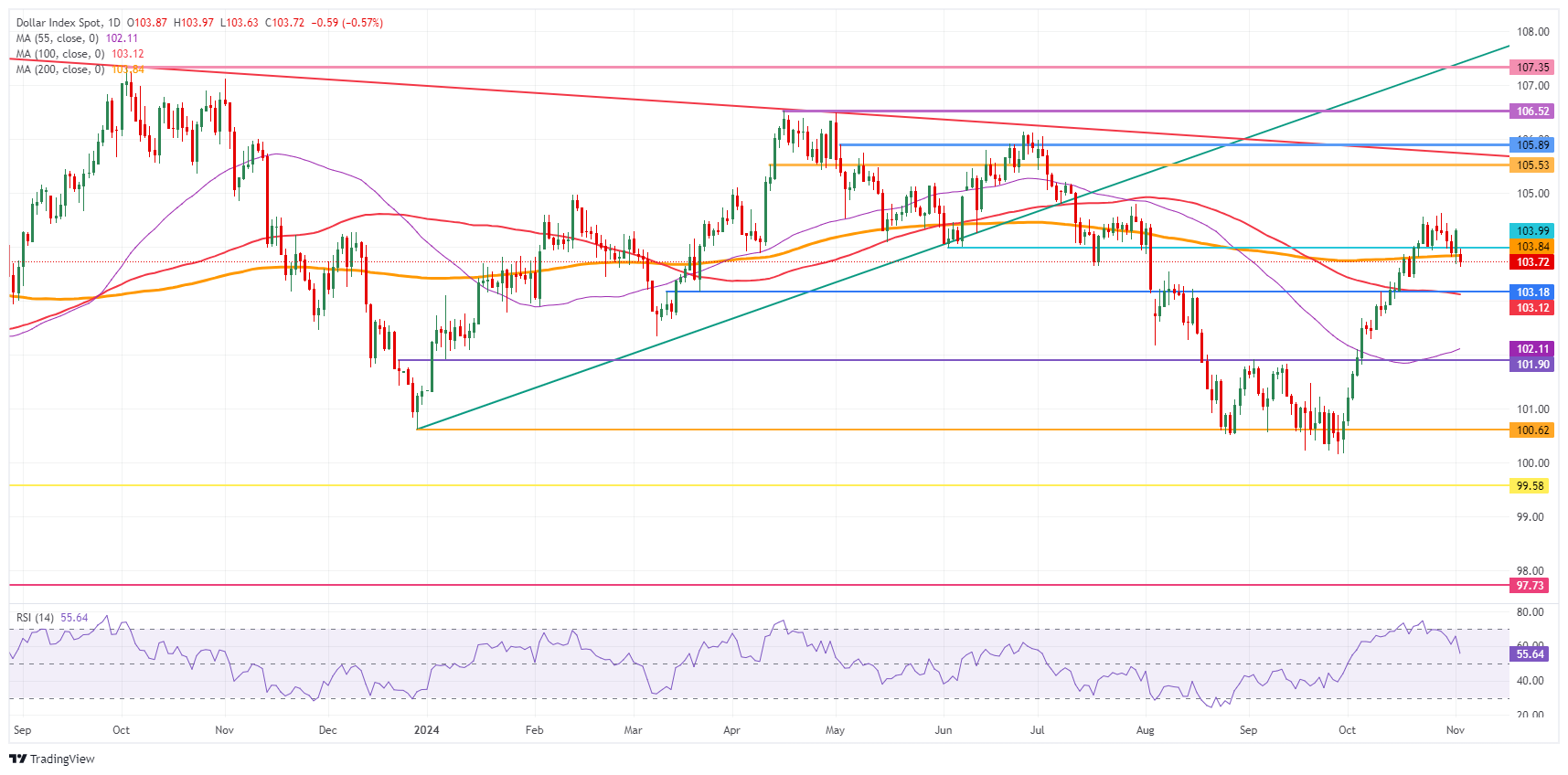US Dollar dips lower after polls reveal Harris securing lead in major swing states ahead of Tuesday’s US presidential election day

- The US Dollar dipped on Monday after Ipsos polls show Vice President Kamala Harris taking the lead in the US presidential elections.
- Traders set for a very volatile week, with the Fed meeting amidst US presidential election uncertainty.
- The US Dollar index slides below 104.00 and is looking for support.
The US Dollar (USD) sees Friday’s gains being erased and dips lower on all fronts on Monday, after a final poll publication from ABC News and Ipsos showed Vice President Kamala Harris leading by 49% against 46% for former President Donald Trump. Another element for more US Dollar weakness comes from The New York Times, which released data pointing that Harris is ahead in five of the seven swing states that will determine the outcome of the US presidential election.
The US economic calendar, meanwhile, needs to be considered as well with a very interesting element ahead this Monday: the Senior Loan Officer Opinion Survey (SLOOS) for the third quarter. The report will tell more on the conditions, supply and demand of loans extended to customers in the US. Loan distribution is a very good leading indicator to sketch how the economy will evolve in the coming weeks and months.
Daily digest market movers: Odds in favor of Harris
- Several analysts and strategist from several big banks are releasing their outlook and reports on the US presidential election outcome this week. Main theme several are reporting on, is that it might take days, even weeks until the actual 60th US President will be known with former US President Donald Trump having filed several court cases in key swing states on election fraude, Reuters reports.
- On Sunday night, the final poll from ABC News and Ipsos showed Vice President Kamala Harris leading by a 49%-46% edge nationally. The New York Times/Siena survey showed Harris being ahead in five of the seven swing states.
- Factory Orders for September are due at 15:00 GMT. Expectations are for orders to contract by 0.4% against the previous decline of 0.2%.
- The Senior Loan Officer Opinion Survey (SLOOS) for the third quarter will be published at 19:00 GMT.
- Chinese equities are very happy with the positive Harris polls and have closed in the green on Monday. European equities and US equity futures are still looking for direction.
- The CME FedWatch Tool is backing a 25 basis point (bps) interest-rate cut on Thursday’s meeting with a 99.7% probability against a marginal 0.3% chance of rates remaining stable.
- The US 10-year benchmark rate trades at 4.29%, lower than the 4.38% where it closed on Friday.
US Dollar Index Technical Analysis: Broader picture
The US Dollar Index (DXY) is set to enter a rough patch of volatility this week, so precautionary measures are needed when trading the US Dollar. Expect to see massive swings, mostly headline driven with even possibly unclear direction and rapid moves days after the election. Bigger levels – such as 102.11 on the downside and 105.53 on the upside – need to be considered as possible outcomes.
The DXY has given up two key levels on Monday and needs to regain control of those two levels first, before considering recovering toward 105.00 and higher. First up is the 200-day Simple Moving Average (SMA) at 103.84 together with the 104.00 big figure. The second element is the high of last week at 104.63.
On the downside, the 100-day SMA at 103.12, together with the pivotal level at 103.18 (high from March 12) are the first line of defence. In case of rapid and volatile moves this week, rather look for 101.90 together with the 55-day SMA at 102.11 to consider as a substantial support level. In case that level snaps, an excursion below 101.00 could be possible.
US Dollar Index: Daily Chart
Fed FAQs
Monetary policy in the US is shaped by the Federal Reserve (Fed). The Fed has two mandates: to achieve price stability and foster full employment. Its primary tool to achieve these goals is by adjusting interest rates. When prices are rising too quickly and inflation is above the Fed’s 2% target, it raises interest rates, increasing borrowing costs throughout the economy. This results in a stronger US Dollar (USD) as it makes the US a more attractive place for international investors to park their money. When inflation falls below 2% or the Unemployment Rate is too high, the Fed may lower interest rates to encourage borrowing, which weighs on the Greenback.
The Federal Reserve (Fed) holds eight policy meetings a year, where the Federal Open Market Committee (FOMC) assesses economic conditions and makes monetary policy decisions. The FOMC is attended by twelve Fed officials – the seven members of the Board of Governors, the president of the Federal Reserve Bank of New York, and four of the remaining eleven regional Reserve Bank presidents, who serve one-year terms on a rotating basis.
In extreme situations, the Federal Reserve may resort to a policy named Quantitative Easing (QE). QE is the process by which the Fed substantially increases the flow of credit in a stuck financial system. It is a non-standard policy measure used during crises or when inflation is extremely low. It was the Fed’s weapon of choice during the Great Financial Crisis in 2008. It involves the Fed printing more Dollars and using them to buy high grade bonds from financial institutions. QE usually weakens the US Dollar.
Quantitative tightening (QT) is the reverse process of QE, whereby the Federal Reserve stops buying bonds from financial institutions and does not reinvest the principal from the bonds it holds maturing, to purchase new bonds. It is usually positive for the value of the US Dollar.
